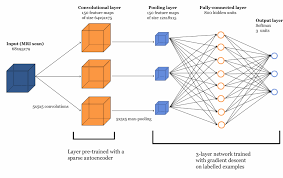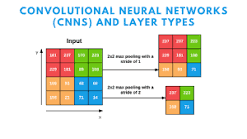The Power of Convolutional Neural Networks in Image Recognition
Convolutional Neural Networks (CNNs) have revolutionized the field of image recognition and computer vision. These deep learning models are designed to mimic the visual cortex of the human brain, allowing them to extract features from images and recognize patterns with remarkable accuracy.
One of the key components of CNNs is the convolutional layer, which applies filters to input images to detect various features such as edges, textures, and shapes. By stacking multiple convolutional layers with pooling layers in between, CNNs can learn hierarchical representations of images, enabling them to understand complex visual data.
Through a process known as backpropagation, CNNs are trained on large datasets to optimize their parameters and improve their ability to classify images. This training process allows CNNs to learn from examples and generalize their knowledge to new, unseen images.
CNNs have been successfully applied in a wide range of applications, including facial recognition, object detection, medical image analysis, and autonomous driving. Their ability to learn intricate patterns and adapt to different types of visual data makes them invaluable tools for solving real-world problems.
In conclusion, convolutional neural networks have transformed the way we approach image recognition tasks. Their ability to automatically learn features from raw pixel data has opened up new possibilities in computer vision and artificial intelligence. As researchers continue to push the boundaries of deep learning technology, CNNs will undoubtedly play a crucial role in shaping the future of image analysis and visual understanding.
Six Essential Tips for Enhancing Convolutional Neural Network Performance in Image Processing
- Preprocess your images by resizing and normalizing them before feeding into the CNN.
- Use data augmentation techniques to create variations of your training images and improve model generalization.
- Start with a pre-trained CNN model like VGG or ResNet for transfer learning on smaller datasets.
- Experiment with different architectures, hyperparameters, and optimization algorithms to fine-tune your CNN performance.
- Visualize intermediate CNN layers to understand feature extraction and detection processes in the network.
- Regularize your CNN model using techniques like dropout or L2 regularization to prevent overfitting.
Preprocess your images by resizing and normalizing them before feeding into the CNN.
To enhance the performance of your convolutional neural network (CNN) in image recognition tasks, it is crucial to preprocess your images by resizing and normalizing them before feeding them into the model. Resizing ensures that all images are of a consistent size, which helps the CNN learn features effectively across different samples. Normalizing the pixel values of the images to a standard range (such as [0, 1] or [-1, 1]) helps in stabilizing and accelerating the training process by making the input data more manageable for the network. By following this preprocessing tip, you can optimize the efficiency and accuracy of your CNN in analyzing and classifying images with improved performance.
Use data augmentation techniques to create variations of your training images and improve model generalization.
To enhance the performance and generalization of your convolutional neural network model for image recognition, it is recommended to utilize data augmentation techniques. By creating variations of your training images through methods such as rotation, flipping, scaling, and adding noise, you can provide the model with a more diverse and robust dataset to learn from. This process helps the model generalize better to unseen data and improves its ability to accurately classify images in real-world scenarios.
Start with a pre-trained CNN model like VGG or ResNet for transfer learning on smaller datasets.
When delving into image recognition tasks with convolutional neural networks, a valuable tip is to kickstart your project by leveraging a pre-trained CNN model such as VGG or ResNet. These established models have already been trained on large datasets and have learned to extract intricate features from images effectively. By utilizing transfer learning on smaller datasets, you can take advantage of the pre-trained model’s knowledge and fine-tune it to suit your specific task. This approach not only saves time and computational resources but also enhances the performance of your CNN model on limited data, making it a strategic choice for efficient and effective image recognition solutions.
Experiment with different architectures, hyperparameters, and optimization algorithms to fine-tune your CNN performance.
To enhance the performance of your Convolutional Neural Network (CNN) in image recognition tasks, it is crucial to experiment with various architectures, hyperparameters, and optimization algorithms. By fine-tuning these aspects of your CNN model, you can optimize its ability to extract features from images and improve its accuracy in recognizing patterns. Through systematic experimentation and analysis, you can discover the optimal combination of parameters that maximizes the performance of your CNN and unlocks its full potential in handling complex visual data.
Visualize intermediate CNN layers to understand feature extraction and detection processes in the network.
Visualizing intermediate layers of a Convolutional Neural Network (CNN) is a powerful technique that provides insights into the feature extraction and detection processes within the network. By examining the activations of these layers, researchers and developers can gain a deeper understanding of how the network transforms input images into meaningful features. This visualization not only helps in debugging and fine-tuning the model but also sheds light on how different layers contribute to the overall image recognition process, enhancing transparency and interpretability in CNN-based applications.
Regularize your CNN model using techniques like dropout or L2 regularization to prevent overfitting.
To enhance the performance and generalization of your Convolutional Neural Network model, it is essential to apply regularization techniques such as dropout or L2 regularization. These methods help prevent overfitting by introducing constraints during the training process. Dropout randomly deactivates a certain percentage of neurons during each iteration, forcing the network to learn more robust and generalized features. On the other hand, L2 regularization adds a penalty term to the loss function based on the magnitudes of the weights, encouraging simpler and smoother weight configurations. By incorporating these regularization techniques into your CNN model, you can improve its ability to generalize well on unseen data and achieve more reliable results in image recognition tasks.



